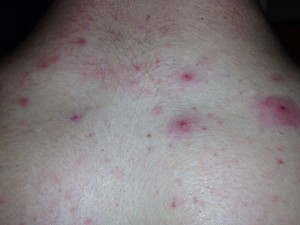An abscess is a painful collection of pus, usually caused by a bacterial infection.
An abscess can develop anywhere in the body. This article focuses on two types of abscess:
- skin abscesses – which develop under the skin
- internal abscesses – which develop inside the body, in an organ or in the spaces between organs
The symptoms of an abscess can vary, depending on which type you have.
A skin abscess often appears as a swollen, pus-filled lump under the surface of the skin. You may also have other symptoms of an infection, such as a high temperature (fever) and chills.
It’s more difficult to identify an abscess inside the body, but signs include pain in the affected area, a high temperature and generally feeling unwell.
See your GP if you think you may have an abscess.
Read more about the symptoms of an abscess and diagnosing an abscess.
What causes abscesses?
Most abscesses are caused by a bacterial infection.
When bacteria enter your body, your immune system sends infection-fighting white blood cells to the affected area.
As the white blood cells attack the bacteria, some nearby tissue dies, creating a hole which then fills with pus to form an abscess. The pus contains a mixture of dead tissue, white blood cells and bacteria
Most skin abscesses are caused by bacteria getting into a minor wound, the root of a hair or a blocked oil or sweat gland. It may be possible to reduce your risk of skin abscesses through good hygiene, a healthy lifestyle and looking after your skin.
Internal abscesses often develop as a complication of an existing condition, such as an infection elsewhere in your body. For example, if your appendix bursts as a result of appendicitis, bacteria can spread inside your tummy (abdomen) and cause an abscess to form.
Read more about the causes of abscesses and preventing abscesses.
How abscesses are treated
A small skin abscess may drain naturally, or simply shrink, dry up and disappear without any treatment.
However, larger abscesses may need to be treated so as to clear the infection, and the pus may need to be drained. This will usually be done either by inserting a needle through your skin or by making a small incision in the skin over the abscess.
Read more about treating an abscess.
Other types of abscess
There are many other types of abscess not fully covered in this article, including:
- an anorectal abscess – a build-up of pus in the rectum and anus
- a Bartholin’s abscess – a build-up of pus inside one of the Bartholin’s glands, which are found on each side of the opening of the vagina
- a brain abscess – a rare but potentially life-threatening build-up of pus inside the skull
- a dental abscess – a build-up of pus under a tooth or in the supporting gum and bone
- a quinsy (peritonsillar abscess) – a build-up of pus between one of your tonsils and the wall of your throat
- a pilonidal abscess – a build-up of pus in the skin of the cleft of the buttocks (where the buttocks separate)
- a spinal cord abscess – a build-up of pus around the spinal cord
